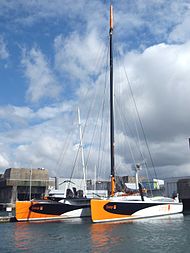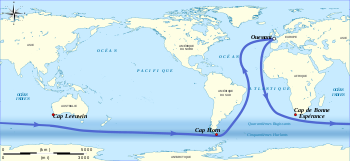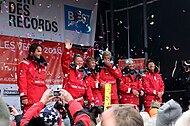Jules Verne Trophy

The Jules Verne Trophy ( French : Trophée Jules Verne ) is a prize awarded for the fastest circumnavigation of the world by sailing boat under certain rules. The trophy remains in the possession of the fastest circumnavigator until a new record is set.
Since the award was made in 1990, many record-breaking sailors have planned their voyages in such a way that they meet the rules of the Jules Verne Trophy. That is why the owners of the prize are usually also the record holders for the fastest circumnavigation of the world (and vice versa).
The prize is named after Jules Verne , the author of the novel Journey around the world in 80 days . The original idea of the Trophy is attributed to Yves Le Corned around 1985, when a circumnavigation of the world in just 80 days became a realistic goal due to the immense advances in boat building. Rules were defined in 1990. A committee made up of several well-known ocean sailors checks that the rules are being observed.
The trophy itself, in other words the “cup” or the sculpture, was designed by the American artist Tom Shannon and hovers over a magnetic field in a glass showcase without contact. Its shape takes up the proportions of the radii of the sun, earth and moon and its proportions are intended to relate to boat hulls and people themselves. It is in the Naval Museum in Paris and was in 1995, when a British-New Zealand crew won the race, at the New Zealand Maritime Museum Hui Te Anaui A Tangaroa in Auckland, which opened in 1993. The floating "boat hull" is only labeled on its underside - in mirror writing - the text can be read as a reflection in the reflective, flat, horizontal surface below. The approximately 2 m long hull and the significantly longer base, which also contains magnets, are only about 10 cm high and are enclosed flush by a glass showcase.
Route and rules
route
Starting line of the Jules Verne Trophy is an imaginary line between the lighthouse Phare du Creach on the French island of Ouessant and Lizard Lighthouse on the British Peninsula The Lizard . When circumnavigating the world, the Cape of Good Hope (South Africa), Cape Leeuwin (Australia) and Cape Horn (South America) must be left to port . The goal is reached when the start / finish line is passed in the opposite direction.
The length of the route is at least 21,600 nautical miles (40003 km). The record from 2017, with a duration of just under 41 days, corresponds to an average speed of around 40.5 km / h or 21.9 knots.
regulate
You can start as soon as the World Sailing Speed Record Council (WSSRC) has taken note of the request, has collected the fees and has given permission.
The rules are: The boat may only be moved by natural wind and physical strength, the circumnavigation of the world has to take place non-stop and without physical influence or help from outside parties. There are no restrictions on ship or crew size, but the successful boats are all multihulls .
winner
| year | Skipper, crew size | nationality | boat | time | World circumnavigation record |
|---|---|---|---|---|---|
| 2017 (January) | Francis Joyon , 6 |
|
IDEC Sport | 40 d 23 h 30 min 30 s | as well |
| 2012 (January) | Loïck Peyron , 14 |
|
Banque Populaire V. | 45 d 13 h 42 min 53 s | as well |
| 2010 (March) | Franck Cammas , 10 |
|
Groupama 3 | 48 d 7 h 44 min 52 s | as well |
| 2005 (March) | Bruno Peyron , 14 |
|
Orange II | 50 d 16 h 20 min 4 s | as well |
| 2004 (April 29) | Olivier de Kersauson , 13th |
|
Geronimo | 63 d 14 h | since March 2004: Steve Fossett (USA) on Cheyenne with a crew of 12 - 58 d 9 h 32 min 45 s |
| 2002 (May) | Bruno Peyron, 13 |
|
orange | 64 d 8 h 37 min 24 s |
also until March 2004, from then on Steve Fossett (USA) on Cheyenne with a crew of 12 - 58 d 9 h 32 min 45 s |
| 1997 (March) | Olivier de Kersauson, 7 |
|
Sport Elec | 71 d 14 h 22 min 8 s | as well |
| 1994/95 (January) |
Robin Knox-Johnston Peter Blake , 8 |
|
Enza New Zealand | 74 d 22 h 17 min 22 s | as well |
| 1993/94 (January) | Bruno Peyron, 5 - including 1 woman |
|
Commodore explorer | 79 d 6 h 15 min 56 s | as well |
The respective winners are invited to a ceremony, glove to bring the core of the trophy made into plastic, which stylizes an approximately 2 m long ship's hull, in the position in which it is repelled by several magnets, stable in the air, about 2 or 3 fingers hovers broadly above a reflective surface.
See also
Other circumnavigations of the world under sail
- Volvo Ocean Race
- Vendée Globe - non-stop and solo regatta around the world
- Barcelona World Race - non-stop and two-person regatta around the world
- Around Alone - solo regatta around the world, with stops in between
- Global Challenge - amateur circumnavigation of the world regattas since 1992 in an east-west direction
Web links
- www.sailspeedrecords.com Official website of the World Sailing Speed Record Council (WSSRC).
- Trophée Jules Verne - Actualités, informations sur les tentatives en cours Updated comparative information on the last competitors. Website of the 2010 record holder, Franck Cammas (French). Last updated in 2017.
- www.boot.de : Jules Verne Trophy: Crew around skipper Franck Cammas started last Thursday [message from February 1st, 2008; Accident on February 18, 2008 with a lead of one day on the record holder].
- Around the world in less than 50 days. With the largest trimaran in the world at the fastest time to win the Jules Verne Trophy? . In: NZZ , October 21, 2008, p. B5.
Individual evidence
- ↑ The sculpture on www.tropheejulesverne.org or on www.tomshannon.com .
- ↑ http://www.idecsport-sailing.com/jules-verne-trophy-interview-with-francis-joyon/?lang=en
- ↑ Yacht Magazine: Incroyable! 40 days! 23 hours! 30 minutes! 30 seconds! - regatta. Retrieved January 26, 2017 .
- ↑ SegelReporter.com: Around the World in 45 Days (January 6, 2012, as of January 6, 2012)
- ↑ spiegel.de: The French sail around the world in record time. Retrieved January 7, 2012 .
- ↑ International Sailing Federation: Groupama 3: How The Round The World Record Was Broken ( Memento of the original from June 21, 2010 in the Internet Archive ) Info: The archive link was automatically inserted and not yet checked. Please check the original and archive link according to the instructions and then remove this notice. (March 23, 2010, as of May 28, 2010)
- ↑ International Sailing Federation: Around the World in 50 Days (March 16, 2005, as of February 20, 2008)
- ^ Fig. 1 (1993) tropheejulesverne.org, accessed December 25, 2018.


